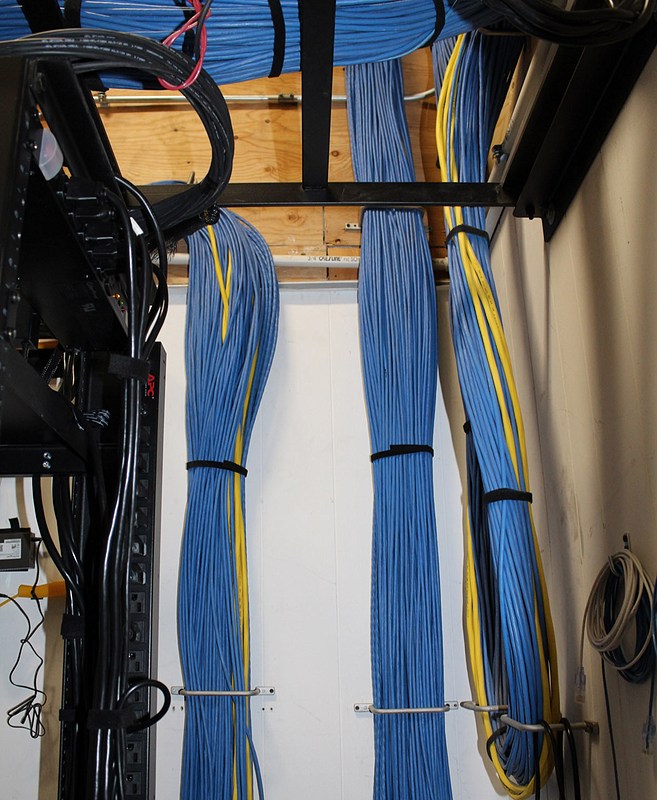PoE LED Lighting in Historic Buildings: 5 Cable Characteristics to Support It
Reducing energy costs in century-old structures poses a special task: finding the right balance between financial savings and integrating today’s technology into yesterday’s architecture.
Dubuque County Courthouse Facilities Superintendent Chris Soeder was doing just that as he watched the building’s utility bills grow: He was looking for potential improvements that would provide cost reductions while maintaining the historic nature of the building. “I averaged more than $6,000 a month for our electric bill,” says Soeder, “and my goal was to decrease that number significantly.”
After learning about Power over Ethernet (PoE) LED lighting – where all components are powered and controlled with an ethernet cable – Soeder realized that this intelligent upgrade might be exactly what the courthouse needed.
Bringing the idea back to his team for discussion, they discovered that supporting the system would require a reliable, high-performance category cable that could also carry power across longer cable runs – especially because of the way the courthouse was designed and constructed.
“Getting wires from point A to point B is sometimes rather convoluted,” explains Soeder. “The cable may go up a floor and back down again just to get to a specific location in the building. We also have walls that are 42 inches thick. In those cases, we try to find an alternate route, which may require longer runs.”
Because this was one of Dubuque County’s first ventures into moving a non-IT system to the network, they took time to determine what they needed from a cable in order to support the lighting system they chose: Innovative Lighting’s GENISYS. Here’s what they came up with …
1. Cable and Connectivity that Don’t Take Long to Install
Because the courthouse doesn’t close during the week, work could only be done on weekends for a finite amount of time.
Lighting system installation involved simply removing the existing fixture, removing existing 110v wiring, installing the new fixture and a small computer that drives and controls the LEDs, and running Category 6A cable.
The courthouse project needed cabling and connectivity that could be installed and terminated just as quickly and easily as the lighting system itself.
2. An Infrastructure that Doesn’t Create IT Problems
“When you tell most people in charge of networks that you’re going to add hundreds of nodes to run IT-based lights – and they’re going to run over your network – it’s exciting and concerning because we’re adding hundreds of new things to our networks,” says Nathan Gilmore, Dubuque County IT superintendent.
As he points out, there are very few factors that can immediately be eliminated as the root cause of a problem during IT troubleshooting. One of the few areas where this is possible, however, is with the cabling system.
The Dubuque County team wanted to be able to immediately rule out cabling as failure point if a performance issue ever came up in the future.
3. A Small, Lightweight Solution
Thick walls, tight spaces and sharp turns would all be an unavoidable part of this project. The cable needed to install with as little disruption to the building – or to people – as possible.
Only a high-performance, small-diameter cable that also had a small bend radius could support PoE LED lighting while also working in some of these historic spaces.
4. Full Performance Across the Entire Channel
When a cable couldn’t be pulled through a certain path or follow a straight line due to thick walls or other challenges, an alternate (longer) cable route would be needed.
For this reason, the courthouse needed an unfailing cabling solution that could reach distances of up to 100 m while maintaining promised performance levels across the entire channel.
5. Cables that Stand Up to Temperature Rise
Cables are rated to transmit data over a specific distance up to a certain temperature. When the cable heats up beyond that point, resistance and insertion loss increase; as a result, the channel reach of the cable often needs to be derated in order to transmit data.
 Many factors cause cable temperatures to rise. At the top of the list is carrying power through cable bundles. As power levels in PoE cables increase, so does the current level running through the cable. The amount of heat generated within the cable increases as well. Bundling makes temperatures rise even more; the heat generated by the current passing through the inner cables can’t escape. As temperatures rise, so does cable insertion loss.
Many factors cause cable temperatures to rise. At the top of the list is carrying power through cable bundles. As power levels in PoE cables increase, so does the current level running through the cable. The amount of heat generated within the cable increases as well. Bundling makes temperatures rise even more; the heat generated by the current passing through the inner cables can’t escape. As temperatures rise, so does cable insertion loss.
Because this was a PoE LED lighting system, power would obviously need to be carried over the cable. Finding one that could manage this heat increase without derating was a must – especially considering some of the cable runs that were necessary.
